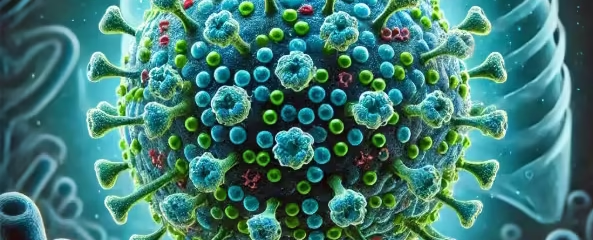
Understanding HMPV Virus: Symptoms, Causes, and Remedies
What is HMPV and How Does It Affect the Body?
The Human Metapneumovirus (HMPV) is a virus recognized as a member of the Paramyxoviridae family, which includes several pathogens known for causing respiratory illnesses. HMPV is particularly noteworthy due to its ability to infect the respiratory tract, leading to a range of symptoms that can resemble those of other viral respiratory infections such as influenza or respiratory syncytial virus (RSV). This virus is primarily responsible for respiratory infections in young children and the elderly, as well as in individuals with compromised immune systems, making these groups particularly vulnerable to its effects.
Infection with HMPV typically occurs when the virus is inhaled or comes into contact with mucous membranes. The virus targets cells in the upper and lower respiratory tracts, leading to inflammatory responses that can result in symptoms such as cough, fever, and nasal congestion. Notably, HMPV has a seasonal prevalence, often peaking during colder months, where close contact in communal settings facilitates its transmission. The virus is spread via respiratory droplets expelled during coughing or sneezing, as well as through contact with contaminated surfaces, making hygiene practices vital for prevention.
Individuals at greatest risk include young children, particularly those under five years of age, older adults, and anyone with underlying health conditions that may weaken their immune response. Those with asthma or chronic obstructive pulmonary disease (COPD) may also experience exacerbated symptoms. Understanding HMPV’s characteristics and transmission pathways is essential for implementing effective public health measures and personal preventive strategies, especially during its peak season.
Symptoms of HMPV Infection
The HMPV (Human Metapneumovirus) infection manifests through a spectrum of symptoms that can range from mild to severe. Common symptoms include cough, nasal congestion, fever, sore throat, wheezing, and shortness of breath. The severity of these symptoms can vary widely among individuals, influenced by factors such as age, underlying health conditions, and immune status.
In young children and elderly individuals, for instance, the symptoms of HMPV can be more pronounced. Infants may exhibit irritability and a decrease in appetite alongside typical respiratory symptoms, complicating the clinical picture. Conversely, in healthy adults, symptoms are often mild and may resolve within a few days, resembling a common cold or mild flu. This variability highlights the importance of recognizing the signs of HMPV infection to seek appropriate medical advice, particularly in vulnerable populations.
The onset of symptoms typically occurs between three to five days after exposure to the virus. This incubation period can lead to confusion in diagnosis, as individuals may not immediately associate their symptoms with HMPV, especially when other respiratory viruses are circulating. In many cases, the symptoms start with a sore throat and nasal irritation, progressively leading to a cough and respiratory distress.
Furthermore, HMPV can exacerbate existing conditions, leading to more severe respiratory issues in individuals with asthma, COPD, or other chronic respiratory diseases. Such exacerbations may require prompt medical intervention. Hence, understanding the variation and impact of HMPV symptoms across different demographics is crucial for promoting timely treatment and effective management of the infection. It is essential for individuals to be vigilant regarding their health and observe whether their symptoms align with those commonly associated with HMPV.
Causes and Risk Factors of HMPV Infection
The Human Metapneumovirus (HMPV) is a significant viral pathogen that contributes to respiratory illnesses, particularly in vulnerable populations. Understanding the causes of HMPV infection is essential for developing effective prevention strategies. The primary mode of transmission involves close contact with an infected individual. HMPV spreads through respiratory droplets, which are expelled when an infected person coughs or sneezes. This mode of transmission emphasizes the importance of maintaining hygiene, particularly in communal settings.
Crowded environments, such as schools, daycare centers, and long-term care facilities, significantly increase the risk of HMPV infection. In these settings, the virus can easily circulate among individuals, leading to outbreaks. Additionally, the virus can survive on surfaces, which means that touching contaminated surfaces or objects followed by touching the face can also facilitate transmission. Awareness of these factors is crucial, especially during periods when respiratory viruses are more prevalent, such as during the fall and winter months.
Several risk factors can heighten the likelihood of contracting HMPV. Individuals with pre-existing health conditions, such as asthma, chronic obstructive pulmonary disease (COPD), or weakened immune systems, are often more susceptible to severe illness caused by the virus. Infants, young children, and the elderly are also at a higher risk due to their developing or declining immune systems. Social determinants, such as access to healthcare and living conditions, may further contribute to these vulnerabilities. Understanding these causes and risk factors enables communities to take proactive measures to reduce the incidence of HMPV and protect those most at risk.
Effective Remedies and Treatment Options for HMPV
HMPV, or Human Metapneumovirus, is a viral infection that primarily affects the respiratory system. Although specific antiviral treatments for HMPV are not currently available, individuals can utilize several supportive care strategies to manage symptoms and promote recovery. Hydration is one of the most critical aspects of treatment; adequate fluid intake helps maintain bodily functions and can alleviate symptoms such as sore throat and cough. It is advisable to drink plenty of water, herbal teas, and clear broths to keep the body well-hydrated.
Additionally, rest plays a vital role in the recovery process. The body requires energy to combat the infection, and sufficient sleep can boost the immune system, speeding up recovery time. Over-the-counter medications, such as acetaminophen or ibuprofen, can be effective in reducing fever and relieving body aches associated with HMPV infection. If a persistent cough or nasal congestion is present, decongestants and cough suppressants may provide symptomatic relief, although it is essential to follow dosing guidelines to avoid adverse effects.
It is also critical for individuals to recognize when medical attention is necessary. If symptoms worsen or do not improve after a few days, or if there is difficulty breathing, chest pain, or high fever, seeking medical advice is imperative. Complications from HMPV can include bronchiolitis or pneumonia, especially in young children, the elderly, or those with compromised immune systems. Therefore, monitoring symptoms closely is essential.
Preventive measures—such as practicing good hygiene, frequent handwashing, and avoiding close contact with infected individuals—are crucial in minimizing the risk of HMPV transmission. Currently, no vaccines specifically prevent HMPV; however, maintaining overall health through proper nutrition and vaccination against other respiratory viruses, like influenza, can bolster immunity. Following these guidelines can help individuals manage HMPV effectively while reducing the chances of severe complications.


